The heroic defense of Smolensk
For more than twenty months, Smolensk has courageously defended his native city. What the enemy troops and the diplomacy of the Polish king could not do through the boyars' traitors, who urged Shein to surrender, made famine and scurvy raging in the besieged fortress: 8 thousand people survived from the large population of Smolensk. By the beginning of June, 1611 had only a total of 200 men in the garrison who could fight. Each warrior had to observe and defend the 20 — 30-meter section of the fortress wall. There were no reserves, as well as hopes for outside help, too.
In the evening of June 2, the last storm of Smolensk began. The traitor-defector Smolensk landowner Dedeshin pointed out a weak spot in the western part of the fortress wall. One of the Knights of the Order of Malta blown down part of the wall. Through the breach, the Poles broke into the city. At the same time, in another place, the German mercenaries climbed the stairs to the part of the fortress wall that no one could guard. The fortress fell.
The defense of Smolensk has once again shown the heroism and self-sacrifice that the Russian people are capable of in battle with enemies. Heroes of Smolensk set the example of his warriors voivod Dmitry Pozharsky. In Nizhny Novgorod, as well as in all corners of the Russian land, with anxiety and pain followed the course of the defense of the city-fortress. His defenders became for Kuzma Minin and Nizhny Novgorod a model of military courage, valor in glory, instilling faith in the future liberation of Russia from the invaders.
prehistory
The ancient Russian city of Smolensk, located on both banks of the Dnieper, is known from chronicle sources from the 862-863. as a hail of the union of Slavic tribes of the Krivichi (archaeological evidence speaks of its more ancient history). From 882, the Smolensk land was joined by the Prophetic Oleg to the united Russian state. This city and land has written many heroic pages in defense of our Fatherland. For more than a thousand years Smolensk became the main fortress on the western borders of Russia-Russia, up to the Great Patriotic War.
The territory of Smolensk land was of strategic importance: the principality was located at the intersection of trade routes. Upper Dnieper was connected with the Baltic through the river. Western Dvina, with Novgorod through the river. Lovat, with the upper Volga. In the early period, it passed through Smolensk from the “Varangians to the Greeks” - from the Baltic and Novgorod along the Dnieper to Kiev and further to the Black Sea and Tsargrad-Constantinople. Then he passed through Smolensk the nearest way from the West to Moscow, therefore the path of most enemies from the West to Moscow always ran through Smolensk.
After the collapse of the united Russian state, the Smolensk principality became independent. In the second half of the XIV century. and the beginning of the XV century. Smolensk land loses its main cities and gradually falls under the authority of the Grand Duchy of Lithuania and Russia. In 1404, Prince Vitovt finally annexed Smolensk to Lithuania. Since that time, the independence of the Smolensk principality was finished forever, and its lands were incorporated into the Lithuanian-Russian state. In 1514, as a result of the successful war for the Moscow Grand Duchy of Lithuania (1512-1522), Smolensk came under the control of Moscow, returning to the Russian state.
Smolensk has always held an important defensive significance in history, so the Russian sovereigns took care of its strengthening. In 1554, by order of Ivan the Terrible, a new, high wooden fortress was built. However, at this time wooden fortresses, taking into account the development of artillery, were no longer considered strong. Therefore, at the end of the XVI century, it was decided to build a new stone fortress on the site of the old one.
In 1595-1602 during the reigns of the kings Fedor Ioannovich and Boris Godunov, the Smolensk fortress wall was built under the guidance of architect Fyodor Kony, with a wall length of 6,5 kilometers and with 38 towers up to 21 meters in height. The height of the strongest of them - Frolovskaya, which was closer to the Dnieper, reached 33 meters. Nine towers of the fortress had a gate. The main passing tower is Frolovskaya (Dneprovskaya), passing through it to the capital. The second most important was the Molokhov Tower, which opened the road to Kiev, Krasny and Roslavl. In the Smolensk fortress wall there was not a single tower, the shape and height of the towers was determined by the relief. Thirteen deaf towers had a rectangular shape. Hexahedral (seven towers) and round (nine) alternated with them.
Wall thickness reached 5-6,5 m, height - 13-19 m, foundation depth more than 4 m. In addition to the wall itself, where it was possible, F. Horse laid ditches filled with water, shafts and ravels. Under the foundations were built "rumors", galleries, moves to eavesdrop on the undermining of the enemy and the location of part of the troops. In the wall were arranged passages for communication with the towers, storerooms for ammunition, gun and gun loopholes. These fortifications played a huge role in the future defense of the city. The architect introduced several new products to his already traditional scheme: the walls became taller - in three tiers, rather than two, as before, the towers are also taller and more powerful. All three tiers of the walls were adapted for battle: the first tier, for the plantar battle, was equipped with rectangular chambers in which the cannons were installed and squeaked. The second tier was for medium combat - they built trench-shaped vaulted chambers in the center of the wall, in which they placed guns. Pushkar climbed to them by the added wooden stairs. Top battle - was on the top of the battleground, which was fenced teeth. Deaf and battle teeth alternated. Between the teeth there were low brick ceilings, due to which the archers could beat from the knee. Above, the platform on which the guns were also installed was covered by a double slope toe-roof.
By the beginning of the war with Poland, the population of Smolensk was up to the siege of 45-50 thousand people (along with the settlement). The city was a strategic fortress on the western border of the Russian kingdom and a major trading center.
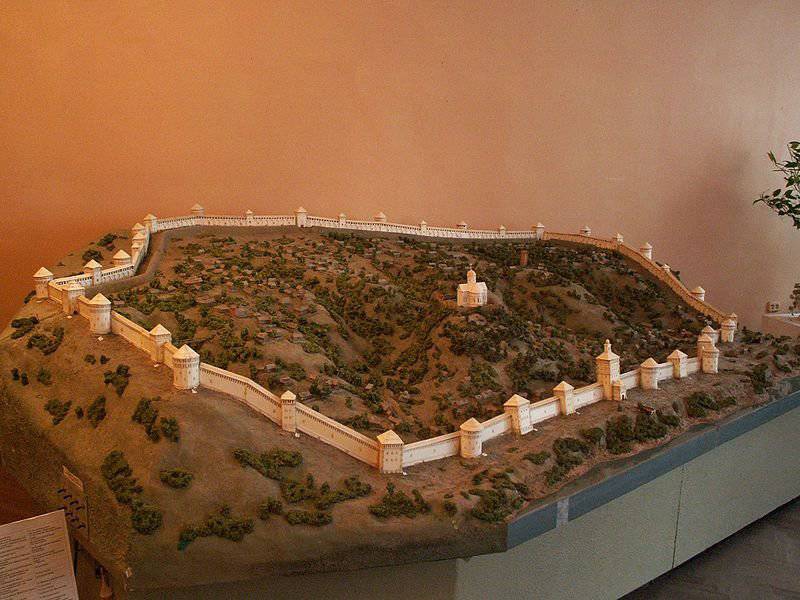
Model of the Smolensk fortress wall
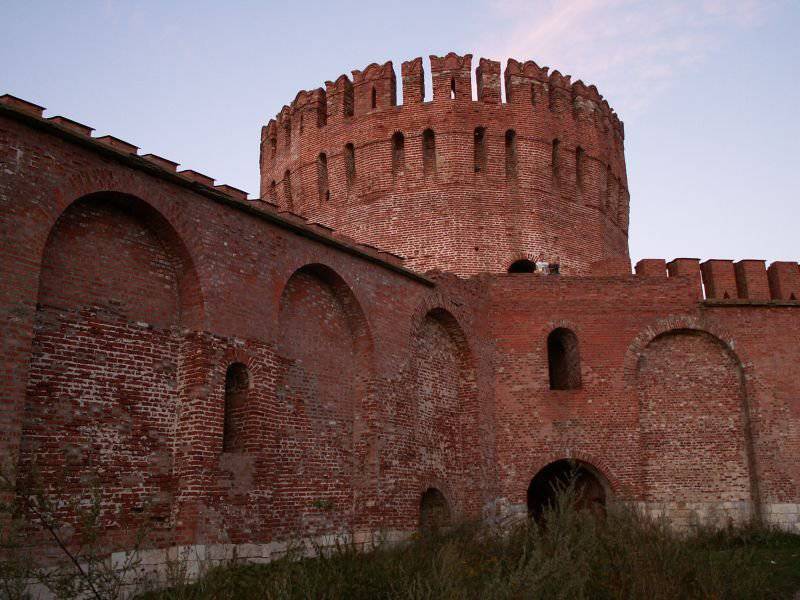
The walls of the Smolensk Kremlin
The situation at the border. The beginning of the fighting
Even before the open war, the Poles, taking advantage of the distemper in the Russian state, raided Smolensk land. The Polish government had information that the king Shuisky had withdrawn the existing troops from the western regions, and there were no border guards on the border. In the autumn - winter 1608-1609. Polish-Lithuanian troops began to focus on borders. As Russian spies were reported to Smolensk, “... Khodkevich’s infantry of seven hundred guns in Bykhov and Mogilev, they said that in the spring they would go to Smolensk”. At the same time, news arrived that 600 soldiers had gathered in Minsk.
From the autumn of 1608, Polish troops began to make systematic raids on the parish of Smolensk. So, in October, Velizhsky elder Alexander Gonsevsky sent a man led by his brother Semyon to Shchuchesky Volost 300. The Gonsevo and Lithuanian Chancellor Lev Sapega suggested that the king go to Moscow via the Smolensk land, therefore he stepped up actions on the Smolensk sector. In addition, Gonsevsky tried to expand his personal possessions, so he planned using the constant threat of ruin to persuade the Smolensk nobility and the peasants to go under royal patronage.
In January, 1609 held a Sejm in Warsaw, at which King Sigismund III offered to build his son Vladislav on the Russian throne. In the winter - in the spring of 1609, the gentry approved their march on Moscow on their seimics. In March and April, in Smolensk, the camps of the enemy army were already reported: “Hungarians, hussars, German infantry, Inflan soldiers with the Pernavsky regiment, two hundred Cossacks, Zaporozhians have letters from Dmitry to go to Smolensk, soldiers from Orsha left their head at Zhmotinsky”, “In Orsha hundreds of horsebacks, one hundred and fifty foot, Bernatni went to Lyubavichi and to Mikula to Velizh, Kolukhovsky, Stebrovsky, Lisovsky, a company of Tatars all went to Vitebsk, waiting for Zhmotinsky, he would go under White with a large army ... from Orsha they write to merchants were not allowed to Smolensk, little charm will be ”(Aleksandrov S.V. Smolensk Siege. 1609 — 1611. M., 2011). In the spring of 1609, Alexander Gonsevsky reinforced the raids. The Poles captured the Šuchichesky and Poretskaya volosts, which facilitated the approach of the royal army to Smolensk and jeopardized the Belian communications through which the Russian fortress maintained contact with the army of Prince Skopin.
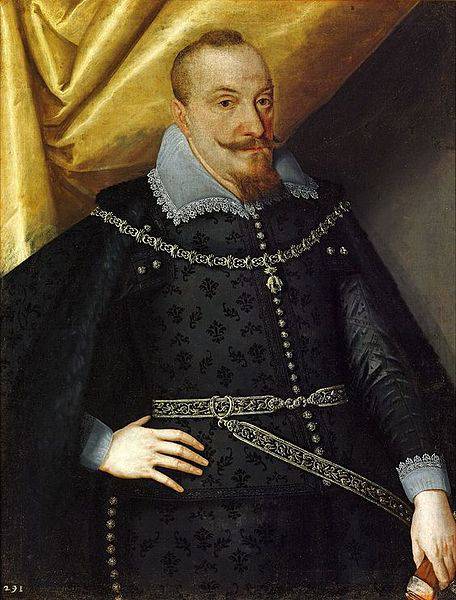
Portrait of Sigismund III Vases, 1610-e. Jacob Trochel. Royal Castle in Warsaw
Voevoda Mikhail Borisovich Shein, who led the defense of the Smolensk land, was an experienced commander. He distinguished himself in the battle of 1605 of the year, near Dobrynichy, when the Russian army inflicted a crushing defeat on the units of False Dmitry I. Shein after this victory was appointed commander of the Advanced Regiment, in 1607 he was promoted to boyar, and in 1608 he occupied one of the most responsible positions in the Russian state - Became the main commander in Smolensk. The voivode had a rich military experience, was distinguished by his personal courage, firmness of character, perseverance and perseverance, and he had broad knowledge in the military field.
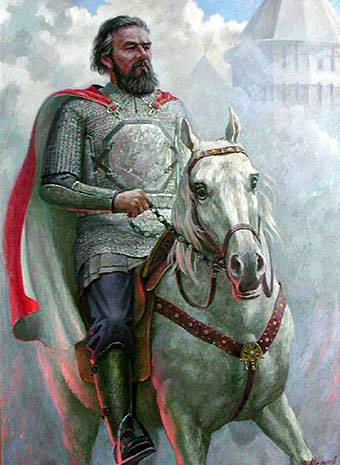
Smolensk voivode, boyar Mikhail Borisovich Shein. Yuri Melkov
Initially, Lithuanian elders blamed robber raids on the “willfulness of the lords”, and Sheinu had to resort to similar tricks in order not to violate the important truce for Russia in the context of the civil war. He directed against the Lithuanian invasions of the border volosts voluntary detachments of "eager people." In the spring of 1609, voivod Mikhail Shein began to set up outposts on Smolensk boundaries. In March, a nobleman Vasily Rumyantsev was sent to Shchuysky Volost with the order “to trade for Lithuanian people, how much God will help them and mark them from the Lithuanian rebate.” However, they turned out to be ineffective: the peasants could not provide serious resistance to the enemy and ran away, and the nobles and children of the boyars did not come or went away, not wanting to fight. In this case, the nobles did not go over to the side of the enemy and did not oppose the royal power, the governor Shein. Nobles cared more about their own welfare, rather than about public service. In addition, a significant and better part of the noble militia went to the connection with the army of Skopin-Shuisky. In May and in the summer of 1609, the town of Shein tried to organize outposts with the help of archers under the guidance of a nobleman, Ivan Zhidovin. But in July, the archers were withdrawn to strengthen the defense of Smolensk, after which Zhidinov was unable to organize the protection of the volosts, and in August the Gonevskys seized Shuchesky volost.
In this case, Shein was the organizer of an extensive intelligence network in the eastern lands of the Commonwealth. The historian V. Kargalov calls Shein in this period the main organizer of strategic intelligence in the western direction of the defense of the Russian state (V. Kargalov. Moscow governors of the 16th-17th centuries. M., 2002). Therefore, Shein was aware of the preparation of Poland for the invasion and the formation of the enemy army in the borderlands. Thus, the Poles were not able to organize a surprise attack, and Smolensk, in view of the available possibilities, was ready for defense.
At the same time, it was necessary to take into account the threat from the Tushins. Under Shein, Smolensk remained loyal to the government of Shuisky and did not succumb to the impostor’s campaign. The delegation that arrived from the Tushinsky thief was arrested by Shein and thrown into prison. Smolensk had to send reinforcements to the Moscow government, despite the threat from the Rzecz Pospolita. In May 1609, Shein sent the most combat-ready part of his garrison from 2 to thousands of military men: three Streltsy orders of 1200 people and 500 — 600 boyars to help the Skopin-Shuisky army approaching Moscow. Thus, the combat capability of the Smolensk garrison was significantly weakened, it had to be restored with the help of the militia, that is, people without combat experience.
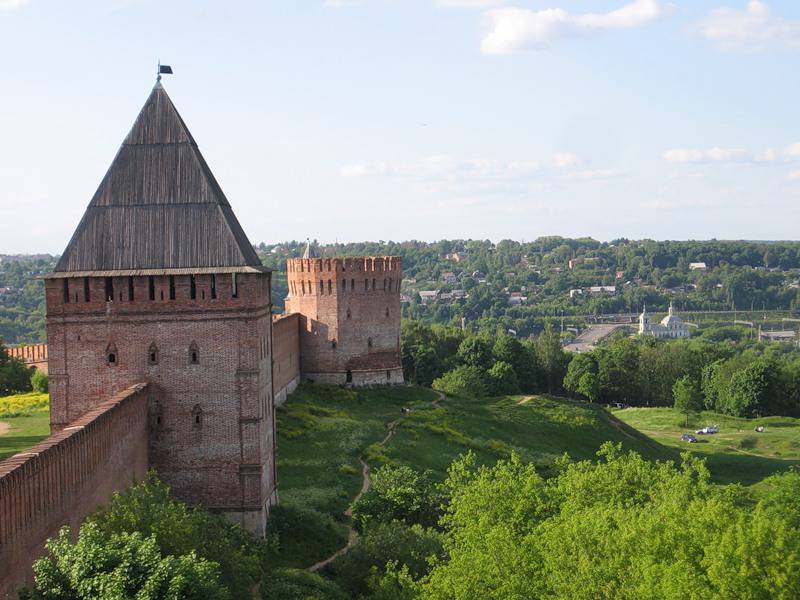
Smolensk Kremlin
Forces of the parties. Preparing a fortress for defense
Thousands of people in the Smolensk garrison in 5,4: 9 of hundreds of nobles and boyars' children, 5 of hundreds of archers and gunners, 4 of thousands of warriors from townspeople and peasants, led by warlord Mikhail Borisovich Shein. The second commander was Peter Ivanovich Gorchakov. In order to somehow compensate for the decline in archers and noblemen who had departed to the aid of the army of Skopin-Shuisky, Shein in August 1609 issued two decrees on the recruitment of receptacles from noble estates and from archbishop and monastic estates. At the end of August the following were composed: the painting of the Smolensk garrison on the towers, the painting of the townspeople and the painting of artillery. Thus, Shein actually formed a new army, and prepared the fortress for a long defense. Although a large part of the garrison consisted of townspeople and dochechnyh people, which reduced its combat capability. But under the protection of the walls of Smolensk and the militia were a serious force, as the 20 month-long heroic defense proved.
The armament of the fortress was 170-200 guns. The guns of the fortress ensured the defeat of the enemy to 800 meters. The garrison had large reserves of manual firearms. weapons, ammunition and food. Back in the summer, the voivode began to prepare for a siege when he received information from the agents that the Polish army would be at Smolensk by 9 August: “The King is smoked by Smolensk by Spasov's days (9 of August), and not by Spasov's days. Smolensk to Cold Days (September 8). ” From that time the voivode began preparing for the defense of the city. According to the plan of defense developed by Shein, the garrison of Smolensk was divided into two groups: siege (2 thousand) and vylaznaya (about 3,5 thousand). The siege group consisted of 38 units (according to the number of towers of the fortress), 50-60 of warriors and gunners in each. She was supposed to defend the wall and the tower. The service at the city walls and towers was carefully painted and under the threat of the death penalty for non-compliance with the painting was strictly controlled. Vylaznaya (reserve) group was the general reserve of the garrison, its tasks were attacks, counterattacks against the enemy, strengthening the most threatened areas of defense in repelling the storms of the enemy troops. The garrison of the fortress could be replenished at the expense of the population of the city, which showed the highest love for the Motherland and supported the defenders with all its might. Thus, thanks to skillful organization, early mobilization and the most severe discipline, it was possible to maximally concentrate all available forces for the defense of the city.
When the enemy army approached Smolensk, the city surrounding the town, including the Zadniprovsk part of the city (up to 6 thousand wooden houses) was burned out by order of the governor. This created more favorable conditions for defensive actions: improved review and firing opportunities for artillery, the enemy was deprived of shelters to prepare for a surprise attack, dwellings on the eve of winter.
The heroic defense of Smolensk in 1609-11 Source: Map from the "Atlas of the Smolensk Region" M., 1964
16 (26) September 1609, forward detachments of the Polish-Lithuanian Commonwealth, which was headed by the Chancellor of the Grand Duchy of Lithuania Lev Sapega, approached the city and began its siege. 19 (29) of September came up and the main forces of the Commonwealth, led by Sigismund III. Initially, the Polish army numbered about 12,5 thousand people with 30 guns. The Polish army included not only Poles, but also Lithuanian Tatars, Hungarian and German mercenary infantry. The weakness of the Polish troops was the small number of infantry, which was necessary for the assault on a strong fortress - about 5 thousand people. Apparently, the Polish king did not initially plan to storm the city, but relied on his quick delivery (according to his data there were only a few hundred soldiers in the fortress) and the further advancement of the whole army deep into the Russian state, but these calculations were not justified. Subsequently, the siege army increased significantly (according to various sources, up to 30-50 thousand cavalry and infantry): more than 10 thousand Zaporozhians and registered Cossacks led by Hetman Olevchenko approached; the bulk of the gentry from the Tushin camp; the number of landsknechts - German, Hungarian mercenaries increased; siege artillery arrived.
Polish troops from all sides blocked the city and occupied all the villages in its vicinity. The property of the peasants of the surrounding villages was plundered, and the peasants themselves were forced to take food to the Polish camp. Many peasants fled to the forests and gathered in partisan detachments. So, one of the units of the Smolensk partisans, under the command of Cod, consisted almost 3 thousands of warriors. The guerrillas destroyed the Polish foragers, boldly attacked the invaders.
The Polish ruler Sigismund III gave Shein an ultimatum of surrender, which was left unanswered by the Smolensk governor. Shein, who delivered the ultimatum to the messenger, stated that if he again appears with such a proposal, he will be “doused with the water of the Dnieper”.
Thus, a sudden blow to the fortress city Smolensk did not work. Thanks to the foresight of the governor Mikhail Shein, who had his spies in Poland, the city was not taken by surprise. The local population managed to hide behind the fortress walls, the suburbs were burned, the necessary reserves were prepared, the garrison was given full combat readiness. On the proposal to capitulate (“to be under the high royal arm”), Shein, who was in charge of the defense, relying on the Zemstvo Council of All Persons, replied that the Russian fortress would defend itself to the last man.
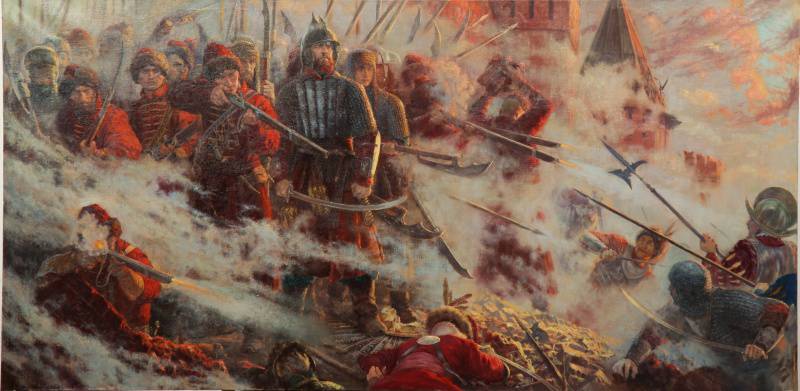
Wall. The defense of Smolensk. Vladimir Kireev
To be continued ...
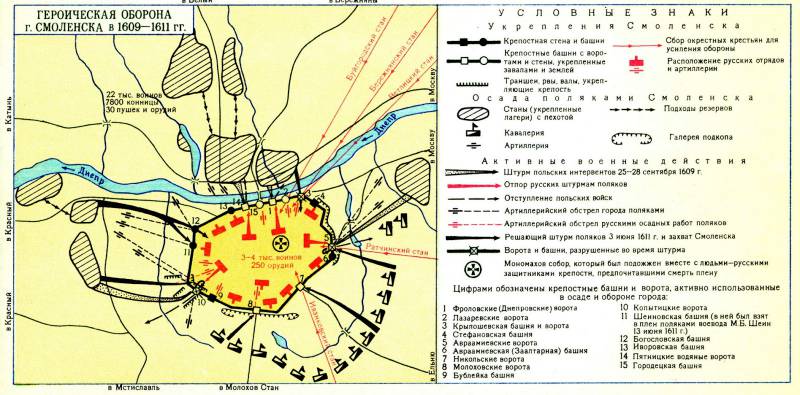
Information